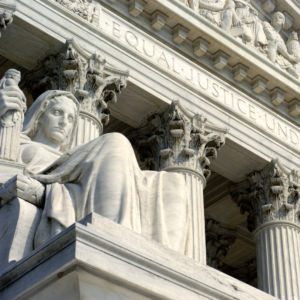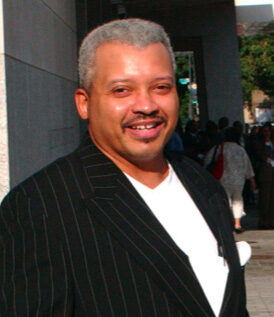Many Americans probably view the U.S. Supreme Court as a collection of black-robed elitists who exist in sort of a secret society. A bunch of stoic traditionalists stuck in centuries past whom we only see in posed photographs or perfectly seated at the president’s annual State of the Union Address.
However, Associate Justice Stephen Breyer struck down that perception when he discussed the evolution of the high court last week. In paraphrasing Paul Freund, the Harvard constitutional law professor for nearly 40 years, Breyer said, “The Supreme Court does not react to the weather, but it sometimes does change with the climate.”
Last week, at the Newseum in Washington, Breyer put a face on the Supreme Court.
Breyer discussed his new book, “The Court and the World: American Law and the New Global Realities,” during an event moderated by NBC News justice correspondent Pete Williams. They focused on noteworthy rulings, world challenges, and the general tenor of the Supreme Court.
In the aftermath of the death of Associate Justice Antonin Scalia, many of us are wondering how can the Supreme Court possibly function with only eight justices. We are probably thinking every case will end tied at 4, like a soccer match. But Breyer quickly corrected that assumption, surprising me with a couple of ultra-relevant statistics when he briefly referenced Scalia’s absence:
—Half of the Supreme Court rulings are unanimous decisions.
—Only about 20 percent are decided with a 5-4 vote.
Except there is a catchy caveat: Let’s face it, those 5-4 cases seem to be the headline-grabbers, the icy-hot ones. No attention deficit disorder here. Remember the court’s Obamacare ruling in 2012 and its ground-breaking gay-marriage decision in 2015 that prompted the Obama administration to illuminate the White House in rainbow colors to honor the ruling.
Though President Barack Obama is facing an obstructionist Senate in his bid to replace Scalia in his final 11 months in the White House, he shouldn’t expect a nominee to always stake his or her court opinion in the president’s corner. Even if Obama chose a liberal replacement.
Breyer cautioned nothing is a sure thing on the decision-making spectrum, evoking a confounded President Theodore Roosevelt in the early 1900s to illustrate his point.
Breyer, who was nominated to the court by President Bill Clinton in 1994, stressed that as presidents serve and exit, philosophies change in the U.S. judiciary. “Over time,” Breyer said, “different presidents appoint different people. And those different people sincerely believe this is how the constitution should be decided. And by the way, if (a) president thinks every case will be decided for him, he’s in for a big surprise. A big surprise.
“Teddy Roosevelt thought Oliver Wendell Holmes would decide everything for him. Three months later, Holmes was on the other side of an antitrust case. And Roosevelt said, ‘I can carve a judge with more backbone out of a banana.’ He was absolutely furious.”
Moral to the Story: Just because a certain president names a certain justice of a certain philosophical leaning doesn’t automatically translate to judicial favor.
We recently saw in real time how change can influence the judicial process in high-stakes situations. The day after Breyer spoke to a packed house of mostly law-school students and Newseum members, Dow Chemical Co. announced it would settle a class-action lawsuit rather than challenge it in the Supreme Court.
Because of Scalia’s death, Dow Chemical opted to pay out $835 million in a case involving price-fixing allegations. Dow Chemical apparently believed there was no hope to overturn a lower court’s ruling in favor of the petitioners because Scalia had been viewed as an ally to companies facing multi-party lawsuits, based on two previous majority opinions the conservative justice wrote that essentially put limits on such suits. Dow Chemical figured Scalia would be the deciding vote in a 5-4 ruling in the company’s favor.
In fact, the Huffington Post displayed this foreboding headline on the Dow case: “Antonin Scalia’s Death Just Cost This Company $835 Million.”
Whoever said the U.S. Supreme Court isn’t hugely important in our daily lives was sadly mistaken. Japanese-Americans — about 120,000 of them, including a 5-year-old George Takei (Mr. Sulu from “Star Trek”) — surely know the importance.
In February 1942, three months after Japan bombed Pearl Harbor, President Franklin D. Roosevelt authorized the rounding up of Japanese-Americans to internment camps, mostly in the western United States. However, a feisty Fred Toyosaburo Korematsu of Oakland, Calif., refused to go; he, instead, went to court. The case eventually reached the Supreme Court, which voted 6-3 in 1944 to uphold internment camps, on the grounds of possible espionage and subversion by Japanese-Americans out of loyalty to Japan.
The highly influential Hugo Black wrote the majority opinion, joined by William O. Douglas and Felix Frankfurter, Stanley F. Reed, Wiley Blount Rutledge and Chief Justice Harlan F. Stone.
Williams asked Breyer to explain Supreme Court justice conference protocol. After hearing arguments in the Japanese internment case, the justices met for their customary closed-door conference. Each justice, Breyer said, speaks based in order of seniority. No justice speaks twice until everyone speaks at least once.
Said Breyer, “In that conference, Black said, ‘Somebody has to run this war. We or Roosevelt. And we can’t do it, so we better do whatever Roosevelt wants.”’
Furthering Breyer’s theme during the discussion with Williams, interestingly enough, four of those justices — Black, Douglas, Frankfurter and Reed — voted 10 years later in the landmark Brown v. Board of Education ruling to strike down legalized racial segregation in the U.S. public school system.
The justices did the right thing in 1954 after doing the wrong thing in 1944. Better late than never.
What loosely can be called a rebuke to Franklin Roosevelt occurred in 1952, during the Korean War. The United Steelworkers Union was set to strike April 8, but President Harry Truman seized control of the steel industry through Executive Order 10340 because he believed a work stoppage would cripple the U.S. war effort.
However, the Supreme Court ruled 6-3 against Truman, stating that a president had limits in power, even in wartime. “In my opinion,” Breyer said, “why did they say that? Because they are fighting Roosevelt. It’s against Roosevelt. And he isn’t around anymore. Harry Truman isn’t as popular, so it’s easier to fight him.”
In a sports parlance, this scenario sounds like a makeup call — such as when a referee tries to atone for an egregious penalty flag thrown in football.
That’s why everyone — domestic and international — should visit Washington to view the Memorial to Japanese-American Patriotism in World War II. It serves as a poignant tribute to Japanese-Americans who helped the U.S. war effort as well as a vivid reminder of the shame of those barbed-wire internment camps.
And it’s only about a 15-minute walk from Breyer’s workplace — the U.S. Supreme Court.
Case closed.


